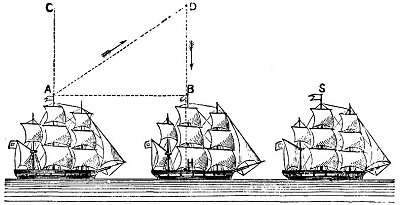1
Flat Earth Investigations / Confused about an experiment in Zetetic Astronomy
« on: July 28, 2018, 04:12:06 AM »
In Chapter III - THE EARTH NO AXIAL OR ORBITAL MOTION., Rowbotham proposes an experiment to test if the Earth is rotating. It goes like this:
Picture a ball on a ship. If you drop the ball from the top of the mast, and the ship is stationary, the ball will fall straight down. If the ship is in motion and you drop the ball, then the ball, relative to the mast, will still drop straight down. This is a result of the ball's momentum given to it by the ship. He relates this to the different models of the Earth. If the Earth was stationary and you dropped a ball, the ball will go straight down, and the same for a rotating Earth.
Rowbotham then proposes that to test whether Earth rotates, you must throw a ball straight up while the ship is in motion. He gives us this image:

His text goes as is:
Rowbotham then says that, because when we throw a ball into the air while standing on Earth's surface, and it does not stop at its peak altitude, this means Earth's surface is not moving under the ball, and thus it is stationary.
This makes no sense. What would cause the ball to lose all horizontal velocity at D? Why would the ball not continue in the horizontal direction as it falls, just as it moved in the horizontal direction as it rose? In real life, if you threw the ball upward while the ship was in motion, it would travel in a vertical line relative to the ship. It would not stop at its maximum altitude, like Rowbotham claims. That's pure nonsense.
This doesn't prove the Earth is flat or round, it just proves Rowbotham was very wrong in his experiment.
Picture a ball on a ship. If you drop the ball from the top of the mast, and the ship is stationary, the ball will fall straight down. If the ship is in motion and you drop the ball, then the ball, relative to the mast, will still drop straight down. This is a result of the ball's momentum given to it by the ship. He relates this to the different models of the Earth. If the Earth was stationary and you dropped a ball, the ball will go straight down, and the same for a rotating Earth.
Rowbotham then proposes that to test whether Earth rotates, you must throw a ball straight up while the ship is in motion. He gives us this image:

His text goes as is:
Quote
put the ship in motion, and let the ball be thrown upwards. It will, as in the first instance, partake of the two motions--the upward or vertical, A, C, and the horizontal, A, B, as shown in fig. 47; but because the two motions act conjointly, the ball will take the diagonal direction, A, D. By the time the ball has arrived at D, the ship will have reached the position, 13; and now, as the two forces will have been expended, the ball will begin to fall, by the force of gravity alone, in the vertical direction, D, B, H; but during its fall towards H, the ship will have passed on to the position S, leaving the ball at H, a given distance behind it.
Rowbotham then says that, because when we throw a ball into the air while standing on Earth's surface, and it does not stop at its peak altitude, this means Earth's surface is not moving under the ball, and thus it is stationary.
This makes no sense. What would cause the ball to lose all horizontal velocity at D? Why would the ball not continue in the horizontal direction as it falls, just as it moved in the horizontal direction as it rose? In real life, if you threw the ball upward while the ship was in motion, it would travel in a vertical line relative to the ship. It would not stop at its maximum altitude, like Rowbotham claims. That's pure nonsense.
This doesn't prove the Earth is flat or round, it just proves Rowbotham was very wrong in his experiment.